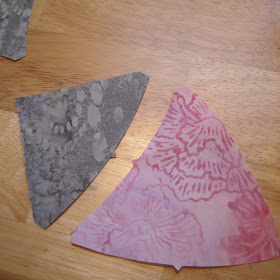For a finished 8" Winding Ways Block, you will need:
1 dark fabric, 10"wide by width of fabric
1 lighter fabric, 10"wide by width of fabric
Thread
Accuquilt Die #55069 Winding Ways
If you don't have this die, or an accuquilt machine, you can copy and paste the 3 pattern pieces below to a word document, resize them on a copier and use them as templates. There are also acrylic templates like these from John Flynn that you can buy for this block. I will warn you that this block must be cut and sewn very accurately to work. The accuquilt makes it easy.
 |
| Piece A |
 |
| Piece B |
 |
| Piece C |
These are the fabrics I used.
If using the accuquilt, cut 10" strips. By the way, I love my new cutting tool, the Gypsy Gripper. It has made ruler slippage almost nonexistent for me.
Start with Pieces B and C

Always sew with the concave piece on top. It will look like a "C" shape on top, as pictured below.

Pin shape B to shape C. Use 3 pins, at the beginning, the end, and one in the middle (at the notch if you are using a die cut shape). I found that inserting the beginning and ending pins with the heads away from the seam worked well for easy removal. Once you have practiced sewing the curved pieces, you will find that you can just finger pin because the accuquilt die cuts the pieces so accurately.
Chain sew whenever possible.
Press seam toward shape B. The correct pressing direction is very important in this block because some of the seams abut each other, as you will see as we go along.
Repeat for remaining BC units.
Next sew two A units together. This is the only seam which you will press open.
Then add an A piece to one of the BC units. Press toward the BC unit.
Add the other BC unit, and again press away from the A piece so your back will look like this. Repeat for other ABC pieces.
Add the two sewn A units to one of the ABC units. I do use one pin in the middle for this line of stitching.
Finally stitch the remaining ABC unit to the piece you just pressed. As you can see, you will be sewing directly next to the previous seam line in the middle.
Press away from the AA unit as before.
TADA! Your finished block!
I love how the back looks as neat as the front.
Happy Sewing ♥



















Nice Color Combination :)
ReplyDeleteGreat tutorial Kym - I love your fabric colors. blessings, marlene
ReplyDeleteExcellent tutorial and pretty fabric selection.
ReplyDeleteWonderful tutorial - thank you!
ReplyDeleteHugs,
Kerry
Great tutorial - thank you
ReplyDeleteI love the colour combination - can you tell what the pink fabric is?
I've wanted to make a curved seam quilt for some time: just a little intimidated! This tutorial makes it seem just little less intimidating, thanks to the wonderful tips. Thank you!
ReplyDeleteI am working on a Winding Ways quilt at this very time, so your tutorial was wonderfully timed! I am having some issues with puckering at the center of the block. Do you have any tips about that?
ReplyDelete